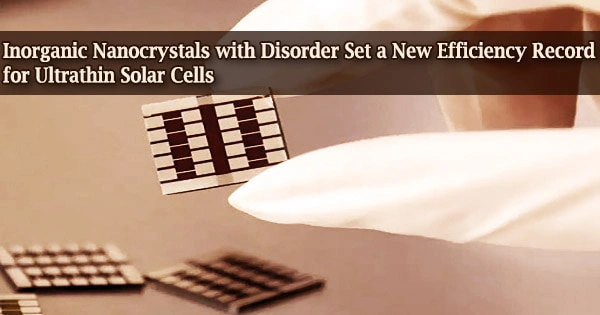Silicon-based solar cells, which can be seen on rooftops and in solar farms, are one of the most efficient technologies for generating electricity from sunlight so far, but their production is costly and energy-intensive, not to mention heavy and large.
The alternate solution of lower-cost thin-film solar cells comes with the drawback of being mostly made of harmful materials like lead or cadmium, or containing rare elements like indium or tellurium.
Solar cells based on AgBiS2 nanocrystals have emerged as a star player in the hunt for new technologies for thin photovoltaic systems, comprised of non-toxic, earth-abundant materials, synthesized in ambient settings at low temperatures and with low-cost solution-processing procedures.
It may be used in ultrathin solar cells and has proven to be exceedingly stable, preventing the cell from degrading over time.
In 2016, ICREA Prof. at ICFO Gerasimos Konstantatos developed a semiconductor absorber 35nm thick solar cell based on AgBiS2 nanocrystals, which were synthesized at very low temperatures (100oC) (an order of magnitude lower than those required for silicon-based solar cells) and engineered at the nanoscale, through a layer-by-layer deposition process, to achieve efficiency in the order of ~6%.
Despite being a promising green alternative to silicon, these cells were unable to achieve compelling performance that was commercially viable.
As a result, many studies have looked into ways to improve their performance and discovered that the optimal thickness of these semiconductor absorbers is closely linked to the absorption coefficients, so the goal would be to develop an ultrathin solar cell with high absorption efficiency, quantum efficiency, and ultimate performance while reducing cost, weight, and manufacturing.
The importance of atomic disorder in emerging inorganic solar cells is currently a hot topic of discussion in the field. Our theoretical investigations of the thermodynamics and optical/electronic effects of cation disorder in AgBiS2 revealed both the accessibility of cation re-distribution and the strong impact of this on the optoelectronic properties.
Seán Kavanagh
However, despite aiming for an ultra-thin layered cell, dealing with light-trapping structures would add cost and complexity to the problem, as the thinner the structure becomes, the more difficult it is to absorb energy.
ICFO researchers Yongjie Wang and Ignasi Burgues-Ceballos, in collaboration with Prof David Scanlon from University College London, Prof Aron Walsh from Imperial College London, and Seán Kavanagh (UCL & Imperial), led by ICREA Prof. at ICFO Gerasimos Konstantatos, have made a significant leap forward and achieved a groundbreaking result in order to overcome this challenge.
Their study, which was published in Nature Photonics, describes a fundamentally new technique to the production of solar cells based on AgBiS2, which allows for absorption coefficients that are higher than any other photovoltaic material employed to date.
Cation disorder
The researchers used an unorthodox approach termed cation disorder engineering to intelligently create the layer of nanocrystals in the cell in their study. They did this by taking AgBiS2 nanocrystals and tuning the atomic locations of the cations within the lattice using a light annealing technique to force a cation inter-site exchange and establish a homogeneous cation distribution.
They were able to demonstrate that this semiconducting material has an absorption coefficient 5-10 times greater than any other material currently used in photovoltaic technology by using different annealing temperatures and achieving different cation distributions in the crystalline arrangement, and that this is true across a spectral range spanning from the UV (400nm) to the infrared (1000nm).
In order to preserve the optoelectronic quality of the nanocrystals after annealing, a new surface chemistry for this new material was required.
As a result, the authors used mercaptopropionic acid as a passivant ligand to keep the material quality while it was annealed. The authors used Density Functional Theory calculations to anticipate and verify the work’s hypotheses, which were supported by experimental evidence.
Seán Kavanagh, a co-first author of the study from UCL and Imperial College, states: “The importance of atomic disorder in emerging inorganic solar cells is currently a hot topic of discussion in the field. Our theoretical investigations of the thermodynamics and optical/electronic effects of cation disorder in AgBiS2 revealed both the accessibility of cation re-distribution and the strong impact of this on the optoelectronic properties.”
“Our calculations revealed that a homogeneous cation distribution would yield optimal solar cell performance in these disordered materials, corroborating the experimental discoveries as a testament of the synergism between theory and experiment.”
As a result, scientists were able to create an ultrathin solution-processed solar cell by layering AgBiS2 nanocrystals over ITO/Glass, one of the most regularly used transparent conductive oxide substrates.
They coated the devices with a PTAA (Poly triaryl amine) solution and measured a power conversion efficiency of more than 9% for a device with a total thickness of less than 100 nm, which is 10-50 times thinner than current thin-film PV technologies and 1000 times thinner than Silicon PV.
One of the winning devices was delivered to a qualified Photovoltaic (PV) calibration facility in Newport, USA, which confirmed an 8.85 percent conversion efficiency under AM 1.5G full sun irradiation.
As the ICFO researcher and first author of the study, Yongjie Wang, comments, “While we noticed a strong darkening of our thin films upon mild annealing due to increased absorption, it was challenging to fabricate such thin devices at the beginning.”
“After grasping control of the process and optimization of the full stack including optimizing electron and hole transport layers, we finally found a highly reproducible structure for efficient solar cells with improved stability. It is really exciting to see that 30nm device gives such a high short-circuit current density up to 27mA/cm2 and an efficiency up to9%.”
As ICREA Prof. at ICFO Gerasimos Konstantatos finally highlights, “the devices reported in this study set a record among low-temperature and solution processed, environmentally friendly inorganic solar cells in terms of stability, form factor and performance.”
“The engineering of the multinary systems with cation disordered AgBiS2 colloidal nanocrystals has proven to offer an absorption coefficient higher than any other photovoltaic material used to date, enabling highly efficient extremely thin absorber photovoltaic devices. We are thrilled with the results and will continue to proceed in this line of study to exploit their intriguing properties in photovoltaics as well as other optoelectronic devices.”
















